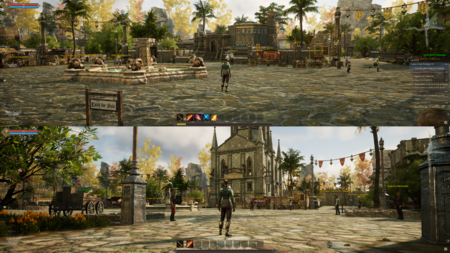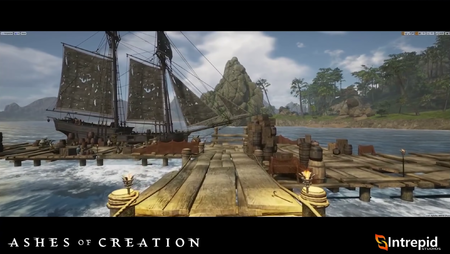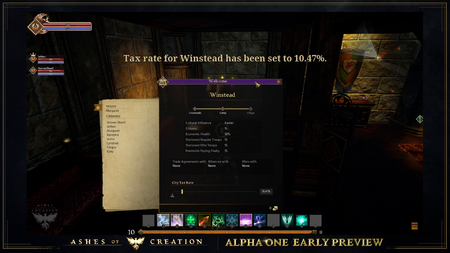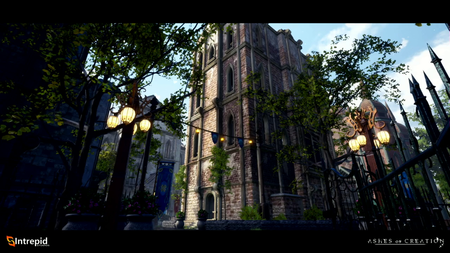| Glorious Wiki readers. We are adding the Midnight Magic video and livestream to the wiki. We appreciate your patience as we process the new and updated information! |
Diferencia entre revisiones de «Node layout and style»
m (Text replacement - "{{Unique node building}}" to "{{Unique node buildings}}") |
(Add section) |
||
| Línea 8: | Línea 8: | ||
{{Node buildings}} | {{Node buildings}} | ||
| + | |||
| + | === Constructible node buildings === | ||
| + | |||
| + | {{Constructibles}} | ||
=== Unique node buildings === | === Unique node buildings === | ||
Revisión del 05:49 10 jul 2020

The layout and architecture within a Node’s development area are determined by influential race. For example, a stage 3 Node with the majority of player contribution being Py'rai would have a Py'rai village with Py'rai architecture. Most NPCs would be Py'rai elves, and offer questlines within the Py'rai narrative.[1] – Margaret Krohn
Each player’s contributed experience is flagged with their character race and other identifiers. When a Node advances, the race with the highest experience contribution determines the Node’s style and culture. This style and culture change can happen at every Node Stage. For example, if a Node advances to Level 2 - Encampment Stage and 51% of all experience was earned by Ren’Kai players, the Node will be a Level 2 Ren’Kai Node. If that same Node advances to a Level 3 - Village Stage Node, but the Py'Rai contributed 62% of all the experience earned, then the Node will be a Level 3 Py'Rai Node.[2] – Margaret Krohn
El diseño de un nodo y su estilo es determinado por varios factores:[3]
- La localización y el entorno (bioma) del nodo.[4][5][3]
- Nodes will adjust the local topography to fit the aesthetic and mechanical requirements of the node.[4] – Steven Sharif
- Los nodos ajustarán la topografía local para adaptarse a los requisitos estéticos y mecánicos del nodo.[6]
Currently the way that the platform system is set up, is it's capable of adjusting the topography of the node's footprint, regardless of the surrounding terrain. So the reason for that is we want to have flexibility in the presentation of the node's layout and how it is essentially both from an aesthetic standpoint as well as a mechanical standpoint with node sieges- how it's constructed and that construction should have the ability to take on a variance of different types of topography. So it shouldn't be dependent on the surrounding area. Now that's not to say that the surrounding area isn't going to have some influence over. So for example... we're experimenting a little bit with the platform tech and putting up a node up against the side of a mountain or on the edge of a cliff or something that has a beautiful vista. Those are things that we're going to test out obviously as we continue to work on the node tool and how that platform system works, but the idea is to have the node independent of the surrounding terrain.[6] – Steven Sharif
- El tipo de nodo.[3]
Some parts are determined by the area it's in. Some parts are determined by the type it is. Some parts are determined by the race it is; and then the rest of it is determined by the mayor.[3] – Jeffrey Bard
- La raza que contribuya con el porcentaje más alto al avance del nodo modificará la apariencia racial de sus edificios, NPCs y objetos.[7][5][2][3][8][9]
- Las razas relacionadas entre ellas no combinan sus influencias culturales. Por ejemplo, los Py'Rai y los Empyrean cuentan como culturas diferentes. Su raza madre, los Pyrian, ya no existen.[10]
- Este cambio de estilo y cultura ocurre en cada etapa del nodo.[2]
- Esto aplica para todos los nodos, incluso los nodos de castillo.[11]
All nodes whether they're associated with a castle or associated with normal node structure has cultural influences that replicate over to the buildings that are produced and the NPCs that are present.[11] – Steven Sharif
- El resto es determinado por el alcalde del nodo.[3]
- Debería ser posible completar varios proyectos de construcción en un nodo durante el mes en el que el alcalde ostenta su cargo.[12]
- Q: How long would you say it will take players on average to fill slash build up a node completely from wilderness to metropolis?
- A: It's one thing to get a node to a certain level: it's another thing to develop the node; and I can't really give you an on-average expectation, because there's a lot of variables at play. There's how many citizens does the node have attracted to it; what's the type of traffic that the node is attracting to it based on things like its tax rates, or the specialization that it chose to spec into, based on the building types it's chosen to build. All of those things are variables that can affect the quote-unquote "average build-out time" of a particular node. So it's difficult to give you an average when there's so many variables along those lines. But the idea is that if there is a particular project that players are interested in in developing based on the node stage, that they would have the ability to complete several of those projects as within a single term of a mayor; and a term of a mayor is one month.[12] – Steven Sharif
Taxation
Los alcaldes pueden establecer los impuestos en sus nodos.[13]
- Esto incluye los impuestos para los juegos de taberna.[14][15]
Los alcaldes/gobernantes de los nodos asignan recursos, impuestos, and misiones para ayudar a desarrollar las defensas de los nodos.[16]
- El dinero de los impuestos solo se puede destinar al desarrollo de los nodos. Este oro no puede ser retirado por el alcalde ni por ningún otro jugador.[17][18]
- Las tasas de los impuestos varían según el momento en el que el jugador se unió al nodo como ciudadano. el objetivo de esto, es aplicar cierta presión financiera sobre las poblaciones de los nodos, haciendo que los impuestos sean cada vez más altos conforme el nodo avanza en lugar de establecer límites de población.[19]
Los nodos madre (soberanos) se llevan una parte de los impuestos de la vivienda así como de los servicios que se den en cualquier de sus nodos vasallos.[17][20]
- Estos impuestos no tienen porqué afectar a los ciudadanos, ya que los niveles de impuestos de los ciudadanos vienen impuestos directamente por su nodo,pero las finanzas del nodo si que se ven afectadas por los impuestos recaudados por los nodos madre (soberanos).[20]
Edificios de nodo
Edificios de nodo edificables
El gobierno del nodo decide la ubicación y los tipos de edificios de nodo que serán edificador en cada sector del nodo.[23][24][25]
These are buildings that the mayor has agency over determining whether or not they should be a constructed project. Constructible buildings can be selected at open plots that are gained as the node advances. If they elect to begin construction of one of these types of buildings- one of which is the marketplace- it'll grant certain trade benefits as well as some stalls that the citizens may participate in.[26] – Steven Sharif
Los gobernantes deciden como especializar su nodo. Una vez determinadas elecciones han sido tomadas no se podrá cambiar a otras opciones.[23]
- Los edificios del nodo disponen de un "arbol tecnológico" basado en la etapa del nodo. Cada etapa ofrece mejores servicios al nodo, pero se debe cumplis con los requisitos previos para la construcción del edificio.[27]
- Diferentes gobernantes pueden cambiar los edificios dentro de un nodo.[23]
And there could be regime change... If somebody doesn't like the fact that a market was built and they want to re-elect a new government next cycle, they can do so... and that market could be destroyed and a new building take its place.[23]
Cuando el tipo de edificios haya sido escogido, la comunidad tiene que traer rrecursos al nodo (empleando caravanas) ay unirse para construirlos (mediante misiones y similares).[23]
- Los materiales aportados para la construcción de un edificio del nodo se pierden si el alcalde desechar el proyecto.[28]
- El número de edificios, así como la localización de los mismos dentro de un nodo están predefinidos.[24]
Edificios de nodo únicos
Cada tipo de nodo tiene asociado un edificio único que puede ser "activado" en la fase de aldea dentro del avance del nodo. Este edificio único juega un rol principal dentro del progreso de la civilización en el servidor.[30]
Misiones raciales
Varias misiones se basarán en la raza de un personaje.[31]
Distintas misiones podrían estar relacionadas con el principal contribuyente cultural de un nodo. Esto no bloqueará contenido, sino que añadirá sazón a las misiones.[31]
Es posible que hayan distintas versiones de la misión que existe para razas específicas; e incluso si se comparte una misión para eliminar un jefe, si tú eres humano y yo soy un elfo, yo podría tener un arco de misión que me lleva en una dirección distinta del tuyo, aunque hayamos tomado la misma misión. Y dependiendo de quién sea el principal contribuyente cultural del nodo, se abrirán nuevos arcos para las culturas que compartan raza con estos contribuyentes. No es que queramos bloquear contenido, sino que queremos darle más sabor a las misiones para que no sean todas iguales.[31] – Steven Sharif
La raza importa porque las distintas narrativas del juego se ven influenciadas por la cultura de los principales contribuyentes de un nodo... Si eres un Niküa y te encuentras en un nodo predominantemente Niküa, tendrás acceso a ciertos servicios o habilidades que los miembros de las otras razas no. Ellos podrían tener misiones alternativas, pero no específicas para su raza. Las misiones específicas de los Niküa estarán relacionadas a la meta-narrativa presente en el mundo y ellos podrán dirigir parte de esa narrativa. Esto será beneficioso para su raza, porque podrán desbloquear cierto contenido al cual las demás razas no tendrán acceso aún. Así que hay un fuerte incentivo de progresión por esa línea.[32] – Steven Sharif
Las misiones específicas para razas, títulos, o gremios probablemente no sean más del 10% de las misiones totales. El otro 90% estarán disponibles para todos.[33]
Reconstrucción del nodo
Un nodo que ha sido destruído por un asedio exitoso se puede desarrollar de forma diferente en función de las siguientes influencias:[5][34]
- Que los principales contribuyentes sean de una Raza diferente.[5][34]
- Los elementos de diseño determinados por los diferentes gobiernos.[5][34]
- Reacciones e interacciones con otros nodos del mundo.[5][34]
Adaptive content

This is actually a dynamic POI. This one will evolve as players evolve the node that it's attached to. So this is its final state.[35] – Jeffrey Bard
Los nuevos puntos de interés (como las mazmorras, jefes de mundo, y zonas corruptas) aparecen conforme los nodos se desarrollan.[36][37]Este contenido se adapta a la progresión del nodo de la zone donde se encuentra.[35][38]
- Aparecerán Edificios adicionales.[35]
- Aparecerán Enemigos adicionales.[35]
- Diferentes antagonistas/líderes con diferentes arcos de historia.[35][38]
- La población cambiará.[38]
- La dificultad del contenido cambiará.[38]
- El contenido puede ser completamente diferente.[38]
- Ganchos de misiones diferentes.[35]
- Las mazmorras se desbloquean cuando el nodo avanza a determinadas fases.[39]
- Múltiples nodos cercanos puede influir de forma colectiva en PDIs (Puntos de interés) más grandes.[40]
- Las mazmorras más grandes obtendrán contenido de mayor nivel a medida que avancen los nodos cercanos.[41][42]
- Los objetivos de la historia para los jugadores en las mazmorras dependerán de los arcos de historia elegidos a través del sistema de nodos.[39]
- Las tablas de drop de zonas y mazmorras dependerán del avance de ciertas áreas.[39]
- Los eventos de punto de interés son eventos relacionados directamente con determinados puntos de interés (POI).[43]
- La ubicación de los puntos de interés será la misma en cada servidor, pero algunos servidores pueden tener acceso limitado o inexistente a los mismos.[44]
- Certain dungeons and other points of interest across the map will all be affected by the server’s node development. Some dungeons will only be unlocked if nodes are developed to certain stages. The storyline objectives for players inside dungeons will also be dependent on the story arc paths chosen through the node system. The drop tables in area and dungeons will also be tied into the progression of certain areas. For example, let’s say that the humans have developed a node in Region A, and a storyline has opened up that leads players to inspect the ruins (dungeon) of a nearby area. And let’s say that this node was developed in a scientific (crafting) zone… Well before the node developed, this dungeon was accessible… But now the dungeon has propagated new monster assets that include a drop table catering to a crafting emphasis because of the development of that academic node. And perhaps, a new boss appears in different rooms of the dungeon that includes different adventure quest starts, like a mysterious item with a storyline that can only be progressed if a node develops to the metropolis stage in a certain region, across the world. Our system is so vast, when it comes to interconnectivity and how the world reacts to the players.[39]
Ver además
Referencias
- ↑ Blog - Know Your Nodes - The Basics.
- ↑ 2.0 2.1 2.2 Blog - Know Your Nodes - Advance and Destroy.
- ↑ 3.0 3.1 3.2 3.3 3.4 3.5 Transmisión en vivo, 2018-09-27 (53:06).
- ↑ 4.0 4.1 Transmisión en vivo, 2022-02-25 (41:00).
- ↑ 5.0 5.1 5.2 5.3 5.4 5.5 Transmisión en vivo, 2020-10-30 (39:17).
- ↑ 6.0 6.1 Transmisión en vivo, 2021-02-26 (1:12:18).
- ↑ Pódcast, 2021-04-11 (29:47).
- ↑ Entrevista, 2018-05-11 (54:34).
- ↑ Transmisión en vivo, 2017-05-26 (21:23).
- ↑ Pódcast, 2021-04-11 (23:36).
- ↑ 11.0 11.1 Entrevista, 2018-05-11 (47:27).
- ↑ 12.0 12.1 Transmisión en vivo, 2022-07-29 (1:13:09).
- ↑ 13.0 13.1 Transmisión en vivo, 2020-03-28 (1:03:38).
- ↑

- ↑

- ↑

- ↑ 17.0 17.1 Transmisión en vivo, 2022-08-26 (1:10:16).
- ↑

- ↑ Entrevista, 2020-03-27 (0:30).
- ↑ 20.0 20.1 Entrevista, 2018-05-11 (57:02).
- ↑ Transmisión en vivo, 2020-03-28 (1:16:03).
- ↑ Vídeo, 2020-03-23 (0:24).
- ↑ 23.0 23.1 23.2 23.3 23.4 Transmisión en vivo, 2017-05-19 (33:57).
- ↑ 24.0 24.1 Transmisión en vivo, 2018-01-20 (38:17).
- ↑ Transmisión en vivo, 2018-04-8 (PM) (51:49).
- ↑ Entrevista, 2020-07-08 (55:05).
- ↑ Transmisión en vivo, 2022-03-31 (1:13:00).
- ↑ Transmisión en vivo, 2021-07-30 (1:10:09).
- ↑ Transmisión en vivo, 2018-09-01 (36:28).
- ↑ Know Your Nodes: Economic Node Type.
- ↑ 31.0 31.1 31.2 Pódcast, 2018-04-23 (29:56).
- ↑ Entrevista, 2018-05-11 (1:00:19).
- ↑ Transmisión en vivo, 2019-07-26 (1:13:23).
- ↑ 34.0 34.1 34.2 34.3 Transmisión en vivo, 2017-05-24 (52:39).
- ↑ 35.0 35.1 35.2 35.3 35.4 35.5 35.6 Transmisión en vivo, 2021-03-26 (50:33).
- ↑ Transmisión en vivo, 2021-03-26 (22:53).
- ↑ Transmisión en vivo, 2017-11-17 (36:22).
- ↑ 38.0 38.1 38.2 38.3 38.4 Transmisión en vivo, 2017-11-17 (18:29).
- ↑ 39.0 39.1 39.2 39.3 MMOGames interview, January 2017
- ↑

- ↑

- ↑ Transmisión en vivo, 2020-07-25 (46:08).
- ↑ Transmisión en vivo, 2022-04-29 (40:21).
- ↑



